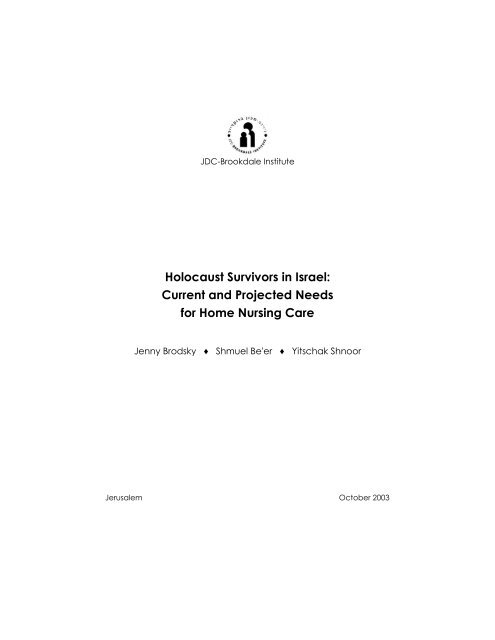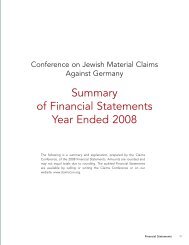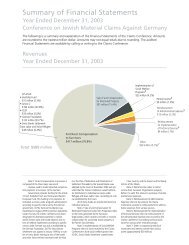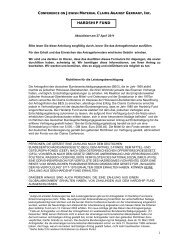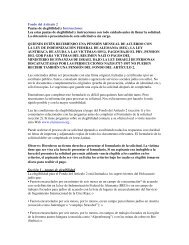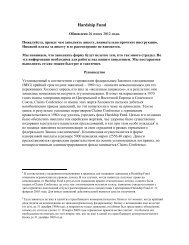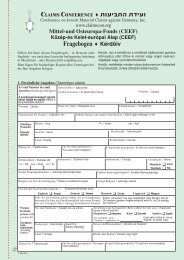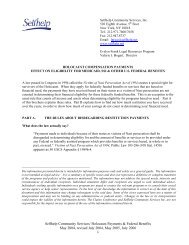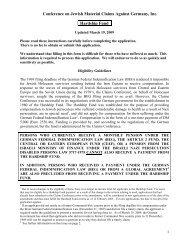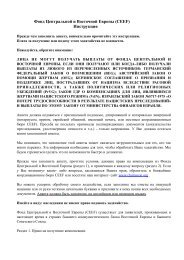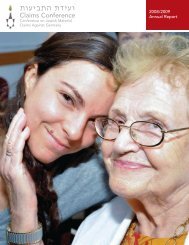Holocaust Survivors in Israel: Current and Projected Needs for ...
Holocaust Survivors in Israel: Current and Projected Needs for ...
Holocaust Survivors in Israel: Current and Projected Needs for ...
You also want an ePaper? Increase the reach of your titles
YUMPU automatically turns print PDFs into web optimized ePapers that Google loves.
JDC-Brookdale Institute<br />
<strong>Holocaust</strong> <strong>Survivors</strong> <strong>in</strong> <strong>Israel</strong>:<br />
<strong>Current</strong> <strong>and</strong> <strong>Projected</strong> <strong>Needs</strong><br />
<strong>for</strong> Home Nurs<strong>in</strong>g Care<br />
Jenny Brodsky ♦ Shmuel Be'er ♦ Yitschak Shnoor<br />
Jerusalem October 2003
For additional <strong>in</strong><strong>for</strong>mation, please contact:<br />
JDC-Brookdale Institute<br />
P.O.B. 3886<br />
Jerusalem 91037 <strong>Israel</strong><br />
Tel: 972-2-6557400<br />
Fax: 972-2-5612391<br />
website: www.jdc.org.il/brookdale
Foreword by the Chairman of The Foundation <strong>for</strong> the Benefit of<br />
<strong>Holocaust</strong> Victims <strong>in</strong> <strong>Israel</strong><br />
To turn one’s eyes away from a site of a terrify<strong>in</strong>g crime or catastrophe is<br />
almost a natural reaction. To struggle with facts which are unexpla<strong>in</strong>able, is<br />
an almost impossible task. To deal with the aftermath of the <strong>Holocaust</strong> is<br />
difficult <strong>and</strong> frustrat<strong>in</strong>g.<br />
Only <strong>in</strong> light of the above may we underst<strong>and</strong> why there are so few records<br />
of the fate of those who reached <strong>Israel</strong> at the end of the Second World War,<br />
<strong>and</strong> are collectively known as “<strong>Holocaust</strong> survivors.”<br />
These people, despite their <strong>in</strong>tegral place <strong>in</strong> the history of the Jewish State,<br />
have received as <strong>in</strong>dividuals very little attention with regard to their social<br />
structure, their education <strong>and</strong> their mental <strong>and</strong> social needs. Today, more<br />
than fifty years after they reached <strong>Israel</strong>, we face problems, <strong>and</strong> we seek<br />
every bit of data that may be able to help <strong>and</strong> to solve pa<strong>in</strong>ful dilemmas<br />
<strong>and</strong> provide some help.<br />
Provid<strong>in</strong>g assistance to these elderly survivors <strong>in</strong> need, who are not capable<br />
of cop<strong>in</strong>g with the problems which time has wrought, should be both a<br />
humanitarian <strong>and</strong> a national commitment.<br />
This study is the result of the work of the staff of the JDC-Brookdale Institute<br />
who took upon themselves to try to resolve a number of questions which did<br />
not seem to have answers. There is no doubt that these f<strong>in</strong>d<strong>in</strong>gs will help to<br />
create a clearer picture <strong>and</strong> ga<strong>in</strong> perspective to respond to needs dur<strong>in</strong>g<br />
the time which rema<strong>in</strong>s.<br />
The Center of Organizations of <strong>Holocaust</strong> <strong>Survivors</strong> <strong>in</strong> <strong>Israel</strong> <strong>and</strong> the<br />
Foundation <strong>for</strong> the Benefit of <strong>Holocaust</strong> Victims <strong>in</strong> <strong>Israel</strong> have the obligation<br />
to give recognition <strong>and</strong> appreciation to the professional staff of JDC-<br />
Brookdale Institute, who faithfully carried out their work. Our thanks to Jenny<br />
Brodsky, Director of the Research Program on Ag<strong>in</strong>g, <strong>and</strong> to researchers<br />
Shmuel Be’er <strong>and</strong> Yitschak Shnoor.<br />
Wolf Zeev Factor<br />
Chairman
Foreword by the Director General of The Foundation <strong>for</strong> the<br />
Benefit of <strong>Holocaust</strong> Victims <strong>in</strong> <strong>Israel</strong><br />
Is it possible <strong>for</strong> data to be poignant?<br />
It would seem not. Data are dry numbers that are the result of statistical<br />
calculations <strong>and</strong> field study. However, <strong>in</strong> this case, the data reveal a difficult<br />
<strong>and</strong> pa<strong>in</strong>ful reality. As the survey f<strong>in</strong>d<strong>in</strong>gs demonstrate, tens of thous<strong>and</strong>s of<br />
<strong>Holocaust</strong> survivors liv<strong>in</strong>g <strong>in</strong> <strong>Israel</strong> today are <strong>in</strong> need of nurs<strong>in</strong>g care. Many<br />
thous<strong>and</strong>s among them are entirely dependent on assistance <strong>in</strong> order to<br />
carry through basic activities of daily liv<strong>in</strong>g. Sadly they are poor <strong>and</strong> do not<br />
have sufficient means to pay <strong>for</strong> the daily aid they need. In the com<strong>in</strong>g<br />
years, as survivors grow older <strong>and</strong> poorer, there will be a greater need <strong>for</strong><br />
nurs<strong>in</strong>g care.<br />
These facts are startl<strong>in</strong>g to people exposed to this issue <strong>for</strong> the first time. The<br />
reality is harsher than <strong>in</strong> the report. <strong>Survivors</strong> who endured the most<br />
horrendous experience, <strong>and</strong> succeeded <strong>in</strong> rehabilitat<strong>in</strong>g themselves <strong>and</strong><br />
earn<strong>in</strong>g their livelihood, are reach<strong>in</strong>g the latter years of their lives, after their<br />
retirement, <strong>and</strong> f<strong>in</strong>d<strong>in</strong>g themselves <strong>in</strong> distress. The little that they managed to<br />
save over the years is not adequate to meet their essential needs, <strong>in</strong>clud<strong>in</strong>g<br />
the cost of expensive medications that are not covered by their health plans,<br />
the purchase of diapers, which they sometimes need, special treatments<br />
<strong>and</strong> the like. Thus, every day, more survivors jo<strong>in</strong> those who need f<strong>in</strong>ancial aid<br />
to manage their nurs<strong>in</strong>g <strong>and</strong> medical care.<br />
In their <strong>in</strong>terpretation of the Book of Exodus (Chapter 30, Verse 12), our sages<br />
declare that the children of <strong>Israel</strong> should not be counted. The sage known as<br />
the Malbim expla<strong>in</strong>s that “a bless<strong>in</strong>g is received <strong>in</strong> a manner that is hidden<br />
from the eye, <strong>and</strong> when they are counted, the bless<strong>in</strong>g is withdrawn.” The<br />
conclusion of the Malbim is paramount: “As long as the nation is united as<br />
one, the public merit is very great.” May this gather<strong>in</strong>g of data be<br />
considered a way of recogniz<strong>in</strong>g our great debt <strong>and</strong> commitment to the<br />
survivors of the <strong>Holocaust</strong>. It is our aspiration that we now fulfill the important<br />
pronouncement:<br />
“All of <strong>Israel</strong> are responsible one <strong>for</strong> the other.” ( " הזל הז םיברע לארשי לכ"<br />
).<br />
Dov (Dubby) Arbel<br />
Director General
Acknowledgments<br />
It is our pleasant duty to thank the people who helped us with this study.<br />
Special appreciation to Ramsis Gera of the Research <strong>and</strong> Plann<strong>in</strong>g Division<br />
of the National Insurance Institute <strong>for</strong> his considerable help <strong>in</strong> provid<strong>in</strong>g data<br />
<strong>for</strong> this study. We are grateful to the staff of the JDC-Brookdale Institute, <strong>and</strong><br />
particularly to Professor Jack Habib, the Director of the Institute, <strong>and</strong> to Haim<br />
Factor, Deputy Director of the JDC-<strong>Israel</strong> <strong>for</strong> their valuable <strong>in</strong>sights. F<strong>in</strong>ally we<br />
thank Jenny Rosenfeld <strong>for</strong> edit<strong>in</strong>g the report, Marsha We<strong>in</strong>ste<strong>in</strong> <strong>for</strong> the<br />
translation <strong>in</strong>to English, Leslie Kl<strong>in</strong>eman <strong>for</strong> graphic design <strong>and</strong> production,<br />
<strong>and</strong> Sue Bubis <strong>for</strong> pr<strong>in</strong>t preparation.
Table of Contents<br />
1. Background 1<br />
2. The Data Base, Methods, <strong>and</strong> Assumptions 2<br />
3. F<strong>in</strong>d<strong>in</strong>gs 5<br />
a) Estimated Size of the Population of <strong>Holocaust</strong> <strong>Survivors</strong>, <strong>and</strong><br />
<strong>Projected</strong> Size up to 2020 5<br />
b) Estimated Size of the Population of <strong>Holocaust</strong> <strong>Survivors</strong> Eligible <strong>for</strong><br />
Services under the Community Long-term Care Insurance Law 8
1. Background<br />
For some time, various agencies <strong>and</strong> <strong>in</strong>dividuals <strong>in</strong> <strong>Israel</strong> have expressed a<br />
need <strong>for</strong> <strong>in</strong><strong>for</strong>mation about <strong>Holocaust</strong> survivors. In particular, an assessment<br />
of the size <strong>and</strong> characteristics of this population <strong>and</strong> its current <strong>and</strong><br />
projected needs is required to facilitate the development of policy <strong>and</strong><br />
sett<strong>in</strong>g of priorities <strong>for</strong> meet<strong>in</strong>g these needs.<br />
The Foundation <strong>for</strong> the Benefit of <strong>Holocaust</strong> Victims <strong>in</strong> <strong>Israel</strong> was established<br />
<strong>in</strong> 1991 by the Central Organization of <strong>Holocaust</strong> <strong>Survivors</strong> <strong>in</strong> <strong>Israel</strong>. The<br />
Foundation works to improve the quality of life of needy <strong>Holocaust</strong> survivors<br />
liv<strong>in</strong>g <strong>in</strong> <strong>Israel</strong>.<br />
One of the pr<strong>in</strong>ciple types of assistance currently provided by the Foundation<br />
is a supplement to the long-term care benefit provided by the National<br />
Insurance Institute under the Community Long-term Care Insurance Law. This<br />
law, which has been <strong>in</strong> effect s<strong>in</strong>ce 1988, m<strong>and</strong>ates home care services to<br />
elderly people who are disabled <strong>in</strong> activities of daily liv<strong>in</strong>g (ADL) such as<br />
bath<strong>in</strong>g, dress<strong>in</strong>g, eat<strong>in</strong>g, <strong>and</strong> <strong>in</strong> basic homemak<strong>in</strong>g activities, such as<br />
prepar<strong>in</strong>g meals. Under the law, services are provided <strong>in</strong> k<strong>in</strong>d <strong>for</strong> between<br />
9.75 <strong>and</strong> 15.5 hours per week, depend<strong>in</strong>g on the elderly person's level of<br />
disability. Disabled elderly, who are partially dependent on other people <strong>for</strong><br />
assistance, receive up to 9.75 hours of assistance per week, which is<br />
considered 100% of the benefit, while the most severely disabled elderly, who<br />
are totally dependent on others <strong>for</strong> per<strong>for</strong>m<strong>in</strong>g basic activities of daily liv<strong>in</strong>g,<br />
receive 15.5 hours of assistance per week, which is def<strong>in</strong>ed as 150% of the<br />
benefit. The Foundation <strong>for</strong> the Benefit of <strong>Holocaust</strong> Victims provides<br />
additional assistance to <strong>Holocaust</strong> survivors who are eligible <strong>for</strong> 150% of the<br />
benefit1 , by provid<strong>in</strong>g them with up to 9 additional hours of personal care<br />
services per week. Those eligible <strong>for</strong> assistance from the Foundation can thus<br />
receive up to 24.5 hours of personal care per week: 15.5 under the<br />
Community Long-term Care Insurance Law, <strong>and</strong> 9 from the Foundation. In<br />
the past, the Foundation provided 10 hours of assistance a week, but<br />
because of budgetary constra<strong>in</strong>ts, assistance was cut down to only 9 hours.<br />
1 Until October 2002 (prior to the implementation of the Emergency Economic Plan),<br />
those eligible <strong>for</strong> 100% of the benefit received 11 hours, while those eligible to 150% of<br />
the benefit received 15 hours.<br />
1
In light of the <strong>in</strong>crease <strong>in</strong> the number of people who have requested<br />
assistance <strong>in</strong> recent years, <strong>and</strong> given the ag<strong>in</strong>g of the population of<br />
<strong>Holocaust</strong> survivors, the Foundation asked the JDC-Brookdale Institute <strong>for</strong><br />
help estimat<strong>in</strong>g the size of the needy population <strong>in</strong> the future, so that the<br />
Foundation would be able to make the necessary preparations, develop<br />
policy, <strong>and</strong> set priorities.<br />
In addition to estimat<strong>in</strong>g <strong>and</strong> project<strong>in</strong>g the number of <strong>Holocaust</strong> survivors<br />
liv<strong>in</strong>g <strong>in</strong> <strong>Israel</strong>, this project <strong>in</strong>volved exam<strong>in</strong><strong>in</strong>g the characteristics of the<br />
population by age, gender, marital status, liv<strong>in</strong>g arrangements, <strong>and</strong><br />
functional <strong>and</strong> health status. This report presents the pr<strong>in</strong>cipal f<strong>in</strong>d<strong>in</strong>gs<br />
regard<strong>in</strong>g the current <strong>and</strong> projected size of the population, <strong>and</strong> of the<br />
population's need <strong>for</strong> long-term care.<br />
2. The Data Base, Methods, <strong>and</strong> Assumptions<br />
We estimated the size of the population of <strong>Holocaust</strong> survivors currently liv<strong>in</strong>g<br />
<strong>in</strong> <strong>Israel</strong>, <strong>and</strong> projected the changes expected <strong>in</strong> this population up to 2020.<br />
On the basis of this estimate <strong>and</strong> the projection, we estimated the number of<br />
<strong>Holocaust</strong> survivors who will be eligible <strong>for</strong> the long-term care benefits, <strong>and</strong> of<br />
those among them who will be eligible <strong>for</strong> 150% of the benefit.<br />
The pr<strong>in</strong>cipal data base <strong>for</strong> this project was a national Survey of People Age<br />
60 <strong>and</strong> Over, which was conducted by the Central Bureau of Statistics (CBS)<br />
<strong>in</strong> 1997 <strong>in</strong> cooperation with the JDC-Brookdale Institute, JDC-<strong>Israel</strong>, ESHEL –<br />
The Association <strong>for</strong> the Plann<strong>in</strong>g <strong>and</strong> Development of Services <strong>for</strong> the Aged<br />
<strong>in</strong> <strong>Israel</strong>, the National Insurance Institute, the M<strong>in</strong>istry of Labor <strong>and</strong> Social<br />
Affairs, the M<strong>in</strong>istry of Immigrant Absorption, <strong>and</strong> the M<strong>in</strong>istry of Health. The<br />
survey <strong>in</strong>cluded <strong>in</strong>terviews with approximately 5,000 people age 60 <strong>and</strong> over,<br />
who constituted a representative sample of all elderly people liv<strong>in</strong>g <strong>in</strong> the<br />
community <strong>in</strong> urban centers. The survey did not <strong>in</strong>clude residents of<br />
<strong>in</strong>stitutions, or residents of rural areas (e.g., kibbutzim <strong>and</strong> moshavim).<br />
The Survey of People Age 60 <strong>and</strong> Over was the first ever to make it possible<br />
to identify the <strong>Holocaust</strong> survivors liv<strong>in</strong>g <strong>in</strong> <strong>Israel</strong>. It accomplished this by<br />
ask<strong>in</strong>g questions about the respondent's country of birth, date of immigration<br />
to <strong>Israel</strong>, <strong>and</strong> ever hav<strong>in</strong>g lived <strong>in</strong> a country that was under the Nazi regime<br />
or direct Nazi <strong>in</strong>fluence. In addition, it asked respondents where they had<br />
2
lived between 1933 <strong>and</strong> 1945, <strong>and</strong> whether, dur<strong>in</strong>g that time, they had been<br />
<strong>in</strong> a ghetto, <strong>in</strong> hid<strong>in</strong>g, <strong>in</strong> a labor camp, or <strong>in</strong> a concentration camp.<br />
A "<strong>Holocaust</strong> survivor" was def<strong>in</strong>ed as anyone who had lived <strong>in</strong> one of the<br />
countries occupied by or under the direct <strong>in</strong>fluence of the Nazi regime at<br />
any time between 1933 <strong>and</strong> 1945. Also <strong>in</strong>cluded <strong>in</strong> this population was<br />
anyone who had fled slightly be<strong>for</strong>e, or dur<strong>in</strong>g, the Nazi occupation (that is,<br />
displaced persons – “fled”).<br />
Accord<strong>in</strong>g to this def<strong>in</strong>ition, about 283,000 <strong>Holocaust</strong> survivors were identified<br />
by the survey; they constituted slightly more than 40% of all Jews age 60 <strong>and</strong><br />
over at the end of 1997. If we exam<strong>in</strong>e all those born <strong>in</strong> Europe only, we f<strong>in</strong>d<br />
that <strong>Holocaust</strong> survivors represented about 75% of them at that time.<br />
As noted, we used the estimated population of <strong>Holocaust</strong> survivors derived<br />
from the 1997 Survey of People Age 60 <strong>and</strong> Over to calculate the current<br />
<strong>and</strong> projected size of that population.<br />
An Estimate <strong>and</strong> Projection of the Population of <strong>Holocaust</strong> <strong>Survivors</strong><br />
We estimated the current size of the population of <strong>Holocaust</strong> survivors, <strong>and</strong><br />
projected its annual progress up to 2020, us<strong>in</strong>g current mortality rates<br />
stratified by age <strong>and</strong> gender. Given the lack of data on the mortality rates<br />
specifically <strong>for</strong> <strong>Holocaust</strong> survivors, we used the mortality rates of people<br />
born <strong>in</strong> Europe-America, s<strong>in</strong>ce most European-born people of these ages are<br />
survivors.<br />
To the population of <strong>Holocaust</strong> survivors derived from the 1997 Survey of<br />
People Age 60 <strong>and</strong> Over, we added relevant populations not <strong>in</strong>cluded <strong>in</strong><br />
that survey. They <strong>in</strong>cluded the follow<strong>in</strong>g:<br />
a. People who <strong>in</strong> 1997 had not yet reached the age of 60. The proportion of<br />
survivors among this group is unknown. It st<strong>and</strong>s to reason that the<br />
proportion of survivors among them would be more similar to the<br />
proportion among the 60-64 age group than to that among the older<br />
survivors. Nevertheless, we assumed that the proportion of <strong>Holocaust</strong><br />
survivors among this group would be 25% of their proportion among<br />
people ages 60-64, as found <strong>in</strong> the 1997 survey. This assumption was<br />
based on two factors: First, only a small percentage of <strong>in</strong>fants <strong>and</strong><br />
3
toddlers survived the <strong>Holocaust</strong>, <strong>and</strong> second, people <strong>in</strong> this age group<br />
are unlikely to be found among the displaced persons – that is, those who<br />
fled shortly be<strong>for</strong>e or dur<strong>in</strong>g Nazi occupation.<br />
b. Immigrants from the <strong>for</strong>mer Soviet Union who arrived <strong>in</strong> <strong>Israel</strong> between<br />
1998 <strong>and</strong> 2001 (based on ongo<strong>in</strong>g CBS population estimates).<br />
c. A projection of those who will immigrate from the <strong>for</strong>mer Soviet Union<br />
between 2002 <strong>and</strong> 2020. We based our projection on three alternative<br />
population projections prepared by the CBS, which took <strong>in</strong>to<br />
consideration the expected immigration to <strong>Israel</strong> us<strong>in</strong>g a high variant, a<br />
medium variant one, <strong>and</strong> a low variant. 2 In this report, we present our<br />
f<strong>in</strong>d<strong>in</strong>gs on the basis of the medium variant. However, it should be noted<br />
that we also estimated the population of <strong>Holocaust</strong> survivors based on<br />
the low variant; <strong>in</strong> several places, we cite these f<strong>in</strong>d<strong>in</strong>gs <strong>in</strong> order to assess<br />
the estimates’ range of sensitivity. The medium variant assumes the arrival<br />
of 230,000 immigrants from the <strong>for</strong>mer Soviet Union between 2001 <strong>and</strong><br />
2020, 25,000 of whom will be elderly (age 65 or over). In contrast, the low<br />
variant assumes the arrival of 130,000 immigrants from the <strong>for</strong>mer Soviet<br />
Union dur<strong>in</strong>g this period, 14,000 of whom will be elderly.<br />
d. People who live <strong>in</strong> the rural sector, that is, <strong>in</strong> villages with fewer than 2,000<br />
residents.<br />
e. People who reside <strong>in</strong> <strong>in</strong>stitutions.<br />
The addition of these populations was calculated on the basis of the<br />
percentage of <strong>Holocaust</strong> survivors found <strong>in</strong> the Survey of People Age 60 <strong>and</strong><br />
Over, by age <strong>and</strong> gender. Their percentage was then applied to each of<br />
the additional populations.<br />
In this study we used <strong>in</strong>stitutionalization <strong>and</strong> mortality rates of people born <strong>in</strong><br />
Europe <strong>and</strong> America. We did not use separate rate <strong>for</strong> immigrants <strong>and</strong> <strong>for</strong><br />
non-immigrants. In order to assess the range of sensitivity of us<strong>in</strong>g separate<br />
rates we did construct such a model, but it yielded almost no differences <strong>in</strong><br />
the results. There<strong>for</strong>e the f<strong>in</strong>d<strong>in</strong>gs presented are based on a model which<br />
uses uni<strong>for</strong>m rates of <strong>in</strong>stitutionalization <strong>and</strong> mortality.<br />
2 These projections were based on the situation of the population at the end of 1995.<br />
At present, the Central Bureau of Statistics is prepar<strong>in</strong>g new population projections,<br />
based on the situation of the population at the end of 2000.<br />
4
Eligibility <strong>for</strong> Receipt of Services under the Community Long-term Care<br />
Insurance Law<br />
We estimated the number of <strong>Holocaust</strong> survivors eligible <strong>for</strong> benefits under<br />
the Community Long-term Care Insurance Law by apply<strong>in</strong>g the rates of use<br />
of services of all those eligible <strong>for</strong> services under the law at the end of 2001 to<br />
the population of <strong>Holocaust</strong> survivors liv<strong>in</strong>g <strong>in</strong> the community, stratified by<br />
age <strong>and</strong> gender. The specific rates <strong>for</strong> the end of 2001 were then applied to<br />
the entire period of the projection (2002-2020). It is important to note that the<br />
1997 Survey of People Age 60 <strong>and</strong> Over did not f<strong>in</strong>d any differences <strong>in</strong> the<br />
use that <strong>Holocaust</strong> survivors or those <strong>in</strong> the general elderly population made<br />
of services provided under the law. Given the lack of differences <strong>in</strong> use, we<br />
felt that the national data, which address the entire population of elderly,<br />
<strong>and</strong> are systematic, reliable, <strong>and</strong> up to date, were preferable.<br />
3. F<strong>in</strong>d<strong>in</strong>gs<br />
a) Estimated Size of the Population of <strong>Holocaust</strong> <strong>Survivors</strong>, <strong>and</strong> <strong>Projected</strong> Size<br />
up to 2020<br />
As can be seen <strong>in</strong> Table 1, the total number of <strong>Holocaust</strong> survivors was<br />
estimated to be 279,000 <strong>in</strong> 20023. This number decl<strong>in</strong>es to 167,000 <strong>in</strong> 2010, <strong>and</strong><br />
to 49,000 <strong>in</strong> 2020. The number of survivors aged 65+ is estimated at 258,000 at<br />
the end of 2002 (93% of all survivors), constitut<strong>in</strong>g 40% of the 65+ population <strong>in</strong><br />
<strong>Israel</strong>. In 2010, the percentage of survivors will be 23% of the 65+ population,<br />
<strong>and</strong> <strong>in</strong> 2020 – 5%. It is important to note that the population of <strong>Holocaust</strong><br />
survivors is ag<strong>in</strong>g. We there<strong>for</strong>e expect an <strong>in</strong>crease <strong>in</strong> the number of<br />
<strong>Holocaust</strong> survivors age 80 <strong>and</strong> over, which will peak <strong>in</strong> 2008, as <strong>in</strong>dicated <strong>in</strong><br />
Table 1 <strong>and</strong> Figure 1. S<strong>in</strong>ce people <strong>in</strong> older age groups are the primary<br />
consumers of services provided under the Community Long-term Care<br />
Insurance Law, the <strong>in</strong>crease <strong>in</strong> their number is important.<br />
When we exam<strong>in</strong>ed changes <strong>in</strong> the population of <strong>Holocaust</strong> survivors<br />
accord<strong>in</strong>g to the low CBS variant, we found no large difference <strong>in</strong> the<br />
estimated size of the population of <strong>Holocaust</strong> survivors. For example,<br />
accord<strong>in</strong>g to the low variant, <strong>in</strong> 2002 the number of survivors was 278,000, <strong>in</strong><br />
2010 it is expected to be 164,000, <strong>and</strong> <strong>in</strong> 2020 it is expected to be 47,000.<br />
3 All the data <strong>in</strong> this report are end-of-year data.<br />
5
Table 1: Estimated <strong>Holocaust</strong> <strong>Survivors</strong> Liv<strong>in</strong>g <strong>in</strong> <strong>Israel</strong>, by Age Group (<strong>in</strong><br />
Thous<strong>and</strong>s, Year End)<br />
6<br />
Age Group<br />
Year Total Up to 59 60-64 65-69 70-74 75-79 80 <strong>and</strong> Over<br />
2002 278.9 5.8 14.6 56.4 61.0 70.2 71.0<br />
2003 265.0 3.1 14.3 49.9 52.0 72.1 73.6<br />
2004 252.0 14.6 43.3 48.7 67.0 78.4<br />
2005 238,6 11.6 32.4 50.5 63.9 80.1<br />
2006 224.1 8.6 23.9 51.7 56.3 83.5<br />
2007 210.1 6.0 14.4 52.3 52.9 84.5<br />
2008 195.9 3.2 14.0 45.9 45.2 87.6<br />
2009 181.3 14.1 39.5 42.2 85.4<br />
2010 166.8 11.1 29.5 43.7 82.5<br />
2015 98.7 10.0 24.8 63.9<br />
2020 49.1 8.4 40.7<br />
Figure 1: Estimated <strong>Holocaust</strong> <strong>Survivors</strong> Liv<strong>in</strong>g <strong>in</strong> <strong>Israel</strong>, by Age Group (<strong>in</strong><br />
Thous<strong>and</strong>s, Year End)<br />
300<br />
250<br />
200<br />
150<br />
100<br />
50<br />
סך Total<br />
הכל<br />
2002 2005 2010 2015 2020<br />
80+<br />
79-75<br />
74-70<br />
69-65<br />
64-60<br />
59עד < 59
S<strong>in</strong>ce this report is concerned with assess<strong>in</strong>g the need <strong>for</strong> nurs<strong>in</strong>g care at<br />
home of <strong>Holocaust</strong> survivors liv<strong>in</strong>g <strong>in</strong> the community, it was important to<br />
calculate separate population estimates by place of residence (that is, <strong>in</strong> the<br />
community, or <strong>in</strong> an <strong>in</strong>stitution). Table 2 presents an estimate of the<br />
population of <strong>Holocaust</strong> survivors by place of residence.<br />
We arrived at the estimated number of survivors liv<strong>in</strong>g <strong>in</strong> <strong>in</strong>stitutions by us<strong>in</strong>g<br />
the <strong>in</strong>stitutionalization rates of people born <strong>in</strong> Europe, as found <strong>in</strong> the census<br />
of residents of <strong>in</strong>stitutions, carried out by JDC-Brookdale Institute <strong>in</strong> 1999-2000.<br />
We assume that these specific rates (by age <strong>and</strong> gender) will not change<br />
dur<strong>in</strong>g the projection period.<br />
Table 2: Estimated <strong>Holocaust</strong> <strong>Survivors</strong> Liv<strong>in</strong>g <strong>in</strong> the Community <strong>and</strong> <strong>in</strong> Longterm<br />
Care Institutions (<strong>in</strong> Thous<strong>and</strong>s, Year End)<br />
Place of Residence<br />
In the Long-term Care<br />
Percentage <strong>in</strong><br />
Long-term Care<br />
Year Total Community Institution Institutions<br />
2002 278.9 265.1 13.8 5.0<br />
2003 265.0 250.9 14.1 5.3<br />
2004 252.0 237.3 14.6 5.8<br />
2005 238.6 223.7 14.9 6.2<br />
2006 224.1 208.9 15.2 6.8<br />
2007 210.1 195.0 15.1 7.2<br />
2008 195.9 180.6 15.3 7.8<br />
2009 181.3 166.5 14.8 8.2<br />
2010 166.8 152.5 14.3 8.6<br />
2015 98.7 88.2 10.5 10.6<br />
2020 49.1 42.7 6.4 13.0<br />
As can be seen <strong>in</strong> Table 2, the number of survivors liv<strong>in</strong>g <strong>in</strong> the community at<br />
the end of 2002 is estimated at 265,000 people. The number of survivors <strong>in</strong><br />
long-term care <strong>in</strong>stitutions is 14,000 people (5% of all survivors).<br />
The number of survivors aged 65+ liv<strong>in</strong>g <strong>in</strong> the community is estimated at<br />
245,000 people, represent<strong>in</strong>g 39% of the 65+ population liv<strong>in</strong>g <strong>in</strong> the<br />
7
community. In 2010 the percentage of survivors liv<strong>in</strong>g <strong>in</strong> the community will<br />
be 22% <strong>and</strong> <strong>in</strong> 2020 – 4% of all elderly aged 65+ liv<strong>in</strong>g <strong>in</strong> the community.<br />
The percentage of survivors expected to be liv<strong>in</strong>g <strong>in</strong> long-term care<br />
<strong>in</strong>stitutions rises over the years as a result of population ag<strong>in</strong>g, as can be seen<br />
<strong>in</strong> Table 2. The number of survivors aged 65+ liv<strong>in</strong>g <strong>in</strong> <strong>in</strong>stitutions at the end of<br />
2002 is estimated at 13.8 thous<strong>and</strong>, constitut<strong>in</strong>g 52% of the 65+ population<br />
liv<strong>in</strong>g <strong>in</strong> <strong>in</strong>stitutions <strong>in</strong> <strong>Israel</strong>. The number of survivors liv<strong>in</strong>g <strong>in</strong> <strong>in</strong>stitutions is<br />
expected to peak <strong>in</strong> 2008 (15.3 thous<strong>and</strong>).<br />
In 2010 <strong>Holocaust</strong> survivors liv<strong>in</strong>g <strong>in</strong> <strong>in</strong>stitutions will still constitute a high<br />
proportion of the residents (48%), <strong>and</strong> this percentage is expected to decl<strong>in</strong>e<br />
to 15% <strong>in</strong> 2020.<br />
Hence<strong>for</strong>th <strong>in</strong> this report we will address only those <strong>Holocaust</strong> survivors who<br />
are liv<strong>in</strong>g <strong>in</strong> the community.<br />
b) Estimated Size of the Population of <strong>Holocaust</strong> <strong>Survivors</strong> Eligible <strong>for</strong> Services<br />
under the Community Long-term Care Insurance Law<br />
First we present an estimate of the number of all <strong>Holocaust</strong> survivors eligible<br />
<strong>for</strong> services under the Community Long-term Care Insurance Law (Table 3),<br />
<strong>and</strong> then an estimate of the number of <strong>Holocaust</strong> survivors who are eligible<br />
<strong>for</strong> services under the law at the level of 150% of the benefit (who comprise<br />
the target population of the Foundation <strong>for</strong> the Benefit of <strong>Holocaust</strong> Victims<br />
<strong>in</strong> <strong>Israel</strong>; Table 4).<br />
At the end of 2002, it was estimated that 45,000 <strong>Holocaust</strong> survivors would be<br />
eligible <strong>for</strong> services under the Community Long-term Care Insurance Law.<br />
This number is not expected to change appreciably through the end of 2005,<br />
<strong>and</strong> is expected to have decl<strong>in</strong>ed to 37,000 people by 2010, <strong>and</strong> to 14,000<br />
by 2020. Nevertheless, because of the ag<strong>in</strong>g of the population of <strong>Holocaust</strong><br />
survivors, those eligible <strong>for</strong> services under the law will represent an <strong>in</strong>creas<strong>in</strong>g<br />
percentage of all <strong>Holocaust</strong> survivors liv<strong>in</strong>g <strong>in</strong> the community. These data are<br />
true <strong>for</strong> the entire population of survivors receiv<strong>in</strong>g services under the<br />
Community Long-term Care Insurance Law, <strong>and</strong> not only <strong>for</strong> those assisted<br />
by the Foundation.<br />
8
Table 3: Estimated Number of <strong>Holocaust</strong> <strong>Survivors</strong> Eligible <strong>for</strong> Services under<br />
the Community Long-term Care Insurance Law (<strong>in</strong> Thous<strong>and</strong>s, Year<br />
End)*<br />
<strong>Holocaust</strong> <strong>Survivors</strong><br />
Year<br />
Total<br />
Liv<strong>in</strong>g <strong>in</strong> the<br />
Community<br />
Eligible<br />
<strong>for</strong> Services<br />
under the Law<br />
Percentage<br />
Eligible<br />
<strong>for</strong> Services<br />
under the Law<br />
2002 265.1 44.5 16.8<br />
2003 250.9 44.4 17.7<br />
2004 237.3 44.3 18.6<br />
2005 223.7 43.8 19.6<br />
2006 208.9 43.2 20.7<br />
2007 195.0 42.4 21.7<br />
2008 180.6 41.2 22.8<br />
2009 166.5 39.3 23.6<br />
2010 152.5 37.3 24.5<br />
2015 88.2 25.4 28.8<br />
2020 42.7 14.4 33.1<br />
* It is important to note that all estimates of eligibility <strong>for</strong> assistance under the Community Longterm<br />
Care Insurance Law <strong>in</strong> this Table are governed by the def<strong>in</strong>ition of the target population<br />
<strong>and</strong> the criteria currently ma<strong>in</strong>ta<strong>in</strong>ed by the National Insurance Institute. If these change, the<br />
data will, per<strong>for</strong>ce, change.<br />
Figure 2: Total <strong>Holocaust</strong> <strong>Survivors</strong> Eligible <strong>for</strong> Services under the Community<br />
Long-term Care Insurance Law (<strong>in</strong> Thous<strong>and</strong>s, Year End)<br />
50<br />
45<br />
40<br />
35<br />
30<br />
25<br />
20<br />
15<br />
10<br />
5<br />
2002 2005 2010 2015 2020<br />
9
Table 4 presents the estimated number of <strong>Holocaust</strong> survivors eligible <strong>for</strong> the<br />
maximum (150%) benefit under the Community Long-term Care Insurance<br />
Law. As noted, this law m<strong>and</strong>ates services to the disabled elderly at two<br />
levels: a benefit <strong>for</strong> those who are partially dependent on assistance from<br />
others (100%); <strong>and</strong> a benefit <strong>for</strong> those who are completely dependent<br />
(150%), which is designed <strong>for</strong> the most severely disabled elderly. However,<br />
some of those whose level of disability makes them eligible <strong>for</strong> the enlarged<br />
benefit actually receive a reduced benefit from the National Insurance<br />
Institute, because their <strong>in</strong>come is higher than the threshold of eligibility set <strong>for</strong><br />
the benefit. The Foundation <strong>for</strong> the Benefit of <strong>Holocaust</strong> Victims <strong>in</strong> <strong>Israel</strong> does<br />
not help these survivors because of their relatively high <strong>in</strong>come, which is<br />
commensurate with, or greater than, the average market wage. It should be<br />
noted that survivors whose level of <strong>in</strong>come is more than 1.5 times greater<br />
than the average market wage are not eligible at all <strong>for</strong> services under the<br />
Community Long-term Care Insurance Law. In calculat<strong>in</strong>g this estimate, we<br />
used the assumption that 75% of all elderly receiv<strong>in</strong>g the reduced benefit<br />
would be <strong>Holocaust</strong> survivors. However, we also exam<strong>in</strong>ed alternative<br />
assumptions, but found no significant difference between the alternatives, as<br />
will be discussed below.<br />
Table 4 presents the estimated number of <strong>Holocaust</strong> survivors eligible <strong>for</strong> the<br />
150% benefit under the law, exclusive of those survivors who receive the<br />
reduced benefit because of their relatively high <strong>in</strong>come. As can be seen <strong>in</strong><br />
Table 4, the number of <strong>Holocaust</strong> survivors eligible <strong>for</strong> the 150% benefit is<br />
expected to peak <strong>in</strong> 2004 at about 11,000 people. The number of elderly<br />
<strong>Holocaust</strong> survivors eligible <strong>for</strong> the enlarged benefit is expected to drop to<br />
about 10,000 people by 2010, <strong>and</strong> to about 4,000 people by 2020.<br />
As noted, we exam<strong>in</strong>ed two alternative assumptions regard<strong>in</strong>g the<br />
proportion of <strong>Holocaust</strong> survivors among those eligible <strong>for</strong> the reduced<br />
benefit. The first alternative assumed that the proportion of recipients of the<br />
reduced benefit among <strong>Holocaust</strong> survivors would be identical to the<br />
proportion of recipients of the reduced benefit among the general elderly<br />
population. Accord<strong>in</strong>g to this assumption, the number of people eligible <strong>for</strong><br />
the reduced benefit at the end of 2002 is slightly higher – 11,000. This number<br />
is expected to peak at 11.2 thous<strong>and</strong> people by 2004, <strong>and</strong> to decl<strong>in</strong>e to<br />
4,000 <strong>in</strong> 2020.<br />
10
Table 4: Estimated <strong>Holocaust</strong> <strong>Survivors</strong> Eligible <strong>for</strong> the Enlarged (150%) Benefit<br />
under the Community Long-term Care Law (<strong>in</strong> Thous<strong>and</strong>s, Year End)*<br />
<strong>Holocaust</strong> <strong>Survivors</strong><br />
Percentage<br />
Total Liv<strong>in</strong>g <strong>in</strong> Eligible <strong>for</strong> Eligible <strong>for</strong><br />
Year<br />
the Community 150% Benefit 150% Benefit<br />
2002 265.1 10.6 4.0<br />
2003 250.9 10.7 4.3<br />
2004 237.3 10.8 4.6<br />
2005 223.7 10.8 4.8<br />
2006 208.9 10.8 5.2<br />
2007 195.0 10.6 5.5<br />
2008 180.6 10.5 5.8<br />
2009 166.5 10.1 6.0<br />
2010 152.5 9.6 6.3<br />
2015 88.2 6.7 7.6<br />
2020 42.7 3.9 9.1<br />
* It is important to note that all estimates of eligibility <strong>for</strong> assistance under the Community Longterm<br />
Care Insurance Law <strong>in</strong> this Table are governed by the def<strong>in</strong>ition of the target population<br />
<strong>and</strong> the criteria currently ma<strong>in</strong>ta<strong>in</strong>ed by the National Insurance Institute. If these changes, the<br />
data will, per<strong>for</strong>ce, change.<br />
Figure 3: Estimated <strong>Holocaust</strong> <strong>Survivors</strong> Eligible <strong>for</strong> the Enlarged (150%) Benefit<br />
under the Community Long-term Care Law (<strong>in</strong> Thous<strong>and</strong>s, Year End)<br />
12<br />
10<br />
8<br />
6<br />
4<br />
2<br />
2002 2005 2010 2015 2020<br />
11
The second alternative made the extreme assumption that all recipients of<br />
the reduced benefit would be <strong>Holocaust</strong> survivors. Accord<strong>in</strong>g to this<br />
assumption, the number of people eligible <strong>for</strong> the reduced benefit was<br />
slightly lower – 10.4 thous<strong>and</strong> people – at the end of 2002, <strong>and</strong> was expected<br />
to peak at 10.5 thous<strong>and</strong> people by 2004, <strong>and</strong> to decl<strong>in</strong>e to 3,900 people <strong>in</strong><br />
2020. The numbers <strong>in</strong> Table 4 represent an <strong>in</strong>terim calculation. In any case,<br />
however, it is possible to see that the estimates based on the various<br />
assumptions do not differ greatly.<br />
Another way to project how many <strong>Holocaust</strong> survivors will be eligible <strong>for</strong><br />
assistance from the Foundation is to use <strong>Holocaust</strong> survivors' current use of<br />
Foundation assistance as a base, i.e. the actual number of people us<strong>in</strong>g the<br />
Foundation’s services, of all survivors liv<strong>in</strong>g <strong>in</strong> the community. Table 5 presents<br />
such a projection. Accord<strong>in</strong>g to Foundation data, 6,300 <strong>Holocaust</strong> survivors<br />
were receiv<strong>in</strong>g assistance <strong>in</strong> mid-2003; Foundation staff estimate that this<br />
number will reach 7,000 by the end of 2003. This projection is based on the<br />
assumption that the current pattern of use of assistance from the Foundation<br />
will cont<strong>in</strong>ue without change. However, we would note that the patterns of<br />
use may <strong>in</strong>deed change, once the service becomes more widely known.<br />
Thus it is possible to calculate alternatives, which assume a relative <strong>in</strong>crease<br />
<strong>in</strong> the patterns of use of Foundation assistance. For example, we calculated<br />
the effect of a 50% <strong>in</strong>crease <strong>in</strong> use. The results of this calculation are<br />
presented <strong>in</strong> Table 5.<br />
Table 5: Estimated <strong>Holocaust</strong> <strong>Survivors</strong> Eligible <strong>for</strong> Foundation Assistance,<br />
based on <strong>Current</strong> Use of Foundation Assistance (<strong>in</strong> Thous<strong>and</strong>s, Year<br />
End)<br />
<strong>Holocaust</strong> <strong>Survivors</strong><br />
Eligible Based on Eligible Based on<br />
Year<br />
<strong>Current</strong> Patterns of Use 50% Increase <strong>in</strong> Use<br />
2003 7.0 7.0<br />
2004 7.1 10.7<br />
2005 7.2 10.8<br />
2006 7.2 10.9<br />
2007 7.2 10.8<br />
2008 7.1 10.7<br />
2009 6.9 10.3<br />
2010 6.6 9.8<br />
2015 4.7 7.0<br />
2020 2.7 4.1<br />
12
Based on the current pattern of use of Foundation assistance, the number of<br />
<strong>Holocaust</strong> survivors who will be eligible <strong>for</strong> assistance from the Foundation is<br />
expected to peak <strong>in</strong> 2006 at 7,240 people. About 6,600 people are<br />
expected to use Foundation assistance <strong>in</strong> 2010, <strong>and</strong> about 2,700 are<br />
expected to use it <strong>in</strong> 2020. If the pattern of use does change, the number of<br />
people eligible <strong>for</strong> assistance from the Foundation may <strong>in</strong>crease; such that<br />
<strong>in</strong> 2006, <strong>for</strong> example, the number of users would be somewhere <strong>in</strong> the range<br />
between 7,200, accord<strong>in</strong>g to the current pattern of use, <strong>and</strong> 10,900, if there is<br />
an <strong>in</strong>crease of up to 50% <strong>in</strong> the pattern of use.<br />
Figure 4: Estimated <strong>Holocaust</strong> <strong>Survivors</strong> Eligible <strong>for</strong> Foundation Assistance,<br />
based on <strong>Current</strong> Use of Foundation Assistance (<strong>in</strong> Thous<strong>and</strong>s, Year<br />
End)<br />
8<br />
7<br />
6<br />
5<br />
4<br />
3<br />
2<br />
1<br />
2003 2005 2010 2020<br />
As can be seen, there are differences between the estimated total number<br />
of <strong>Holocaust</strong> survivors who will be eligible <strong>for</strong> assistance from the Foundation<br />
based on the two alternative assumptions discussed above -- the estimate<br />
based on patterns of utilization of the enlarged (150%) benefit under the<br />
Community Long-term Care Law (Table 4), <strong>and</strong> the estimate based on<br />
current use of Foundation assistance (Table 5). In mid-2003, the gap<br />
between the estimates was calculated to be 3,600 elderly people. In other<br />
words, some <strong>Holocaust</strong> survivors who are eligible <strong>for</strong> Foundation assistance<br />
13
may not be receiv<strong>in</strong>g it. A number of factors may expla<strong>in</strong> this, chief among<br />
them the follow<strong>in</strong>g: Some survivors may be receiv<strong>in</strong>g services from other<br />
organizations (such as the Association of Immigrants from the Netherl<strong>and</strong>s);<br />
<strong>and</strong> some survivors may not seek assistance – either because of the stigma<br />
associated with it; because of the bureaucratic procedures <strong>in</strong>volved <strong>in</strong><br />
procur<strong>in</strong>g it, e.g. the stipulation that a social report be filled out by a social<br />
worker from the local authority (this is especially true of solitary elderly people<br />
who do not have children to help them); or because of a lack of awareness<br />
of the assistance that is available from the Foundation. If utilization patterns<br />
grow by 50%, the estimate of people us<strong>in</strong>g the Foundation’s assistance <strong>in</strong> the<br />
peak year (2006) will reach 10.9 thous<strong>and</strong>.<br />
This paper presented estimates of the numbers of <strong>Holocaust</strong> survivors liv<strong>in</strong>g <strong>in</strong><br />
<strong>Israel</strong> today <strong>and</strong> <strong>in</strong> the future. We focused on the area of nurs<strong>in</strong>g care, but it<br />
should be noted that there are needs <strong>in</strong> other areas as well, such as <strong>in</strong> the<br />
social <strong>and</strong> health areas. Note also that based on the survey of people aged<br />
60+, <strong>in</strong><strong>for</strong>mation exists regard<strong>in</strong>g the additional needs of survivors; this<br />
<strong>in</strong><strong>for</strong>mation was presented at various opportunities to services developers<br />
<strong>and</strong> decision makers work<strong>in</strong>g with this population.<br />
14
S-108-03<br />
15


